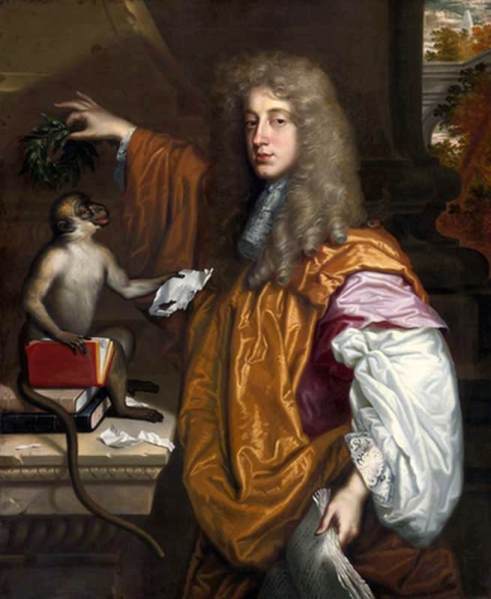Part three of Nothing
That damned monkey has led me somewhere I swore I would not go……

The best-known portrait of the young and dashing Prince Rupert, Count Palatinate (1619 – 16800 by Honthorst, oil on panel, feigned oval, circa 1641-1642. Image: © National Portrait Gallery, London
For the first two years of the Civil War Rupert’s success as a cavalry leader deploying shock tactics dominated the fighting. He seemed to be invincible. The Parliamentarian propagandists instilled the idea into their supporters that his pet monkey was a disguised witch who had sex with the prince, and, along with his other familiar in the shape of a huge white dog, gave the Cavaliers victory through sorcery.

Parliamentary propaganda depicted Prince Rupert’s poodle Boye as his familiar, an agent of black magic. The Roundhead troops who killed the beautiful animal at Marston Moor believed they were destroying the source of Royalist luck, and in particular, the power of the hated foreign general. Woodcut, illustrating a pamphlet called The Cruel Practices of Prince Rupert, 1643. Image: Wikipedia
It was preposterous, hardly anybody believed in witchcraft in normal times during the 17th century, but the 1640s were not normal. It was, after all, the age of Matthew Hopkins, self-appointed Witchfinder-General, exploiting the public’s paranoid fears during a terrifyingly violent and unstable period, when everyday life and relationships had broken down.
Rupert’s personality and appearance made him easy for both sides to demonize to their advantage. He was young and arrogant, tall and handsome, talented and, most significantly, foreign, all of which made him obnoxious to a lot of people, Royalist and Parliamentarian, and inspiring to his own men.
It was well known that he had a diabolical temper: his brothers and sisters called him Rupert the Devil.
It was true that the dog, Boye, was a beloved companion, but not for sexual purposes. He was not the source of a prince’s superpowers, nor even a trained dog of war, just the most famously tragic hunting poodle in history, who was always tied up at the Royalist camp before one of Rupert’s battles.
On only one occasion, Boye escaped his leash, or, terrible to contemplate, Rupert or his servants had forgotten to tie him up, and he instinctively sprang forward with glee, as any dog would, to follow his master.
But when Rupert rode off, it wasn’t to a hunt, it was straight into battle. Boye was killed instantly by enemy fire and hacked to bits in an atrocity fomented by human ignorance and prejudice.

Gijsbrechts, Trompe l’oeil with Christian V of Denmark’s Equipment for Riding to Hounds, 1671. The artist’s power of illusion is applied to the leisure pursuits of the powerful. With thanks yet again to: SMK – Statens Museum for Kunst, Copenhagen for the free use of this image of a painting from their collection.
The “Wrong but Wromantic” Royalist cause was lost, not because a spell was broken, but because of the superiority of Cromwellian strategy, tactics and discipline, and the political and military ineptitude of the king, who didn’t take Rupert’s pragmatic advice the following year, 1645, to start peace negotiations before his position got worse.
(The quote, for anyone neither British nor of a certain age, is from a comic work of genius published in 1930, called 1066 and All That, one of the most truthful books in the spirit of history ever written.)
Credulity and coincidence often make history and still inform election choices in modern democracies. Just because there isn’t an official Witchfinder-General today, doesn’t mean to say there aren’t a lot of them about under different titles. We’re all frightened of one thing or another, all willing to believe in something, even if we call it nothing.
Marston Moor was Rupert’s first and worst defeat as a general and a rite of passage into accountability and remorse. He had suffered before, and been held, aged nineteen, as a prisoner of war in Europe for three years, but after Marston Moor he was never quite the same. All is vanity.
A note for purists of military history and Rupertists: he always maintained that he was misled by ambiguous written instructions from Charles I to seek battle at Marston Moor, a strategically disastrous decision which lost the north of England to Parliament. The letter survives in evidence.
Rupert was a strange (and terribly attractive) mixture of arrogance and fidelity; he had the fatal flaw of many other proud and intelligent Germans of obedience to authority.
And Rupert, the professional European soldier, should never have been so reckless to take his dogs on campaign in England, certainly not without locking up, poor Boye during a battle; civil wars are always fought with savage bitterness outside the rules of engagement of other conflicts.
Maybe he had started believing his own publicity; he was only twenty-four.
A 6’4″ German prince who last breathed in 1682 – a whisker and a whisper ago – has rudely attacked my train of thought – it must be love that makes me tarry –
the journey into Nothing will be continued when I’ve found that monkey….
 Margaret Hughes (c 1630 – 1719), one of the first, if not the first, woman to appear professionally on the English stage after the Restoration, as Desdemona in the King’s Company production of Othello in December, 1660, in a portrait by Lely, c. 1670, with fashionable accessory of adoring spaniel. She became Rupert’s mistress after 1668, and continued her acting career spasmodically, in the lucky position of being able to choose her parts.
Margaret Hughes (c 1630 – 1719), one of the first, if not the first, woman to appear professionally on the English stage after the Restoration, as Desdemona in the King’s Company production of Othello in December, 1660, in a portrait by Lely, c. 1670, with fashionable accessory of adoring spaniel. She became Rupert’s mistress after 1668, and continued her acting career spasmodically, in the lucky position of being able to choose her parts.


